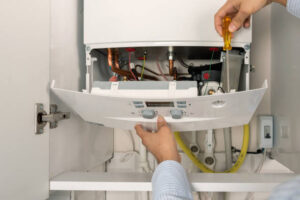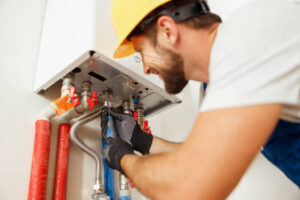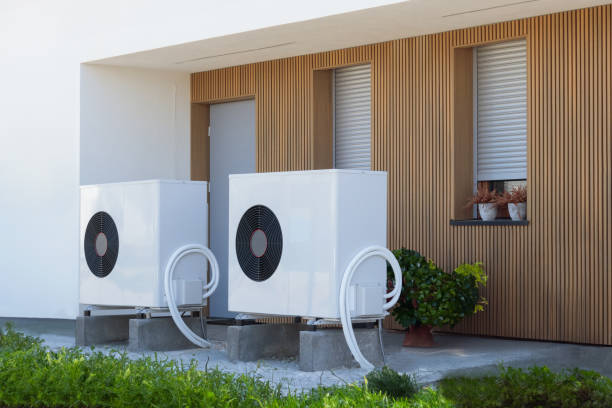As the leaves turn and the air chills, the importance of a reliable heating system becomes undeniable. Whether nestled in a cozy residential home, bustling within a commercial space, or operating in an industrial setting, the quest for maintaining a warm and comfortable indoor environment unites us all. But what exactly goes into a heating system?
From the warmth generated by electricity, gas, oil, or even renewable sources, to the distribution via vents, pipes, or radiators, the journey of heat from creation to comfort is both fascinating and essential. This article delves into the heart of heating systems, exploring how they keep the cold at bay, the variety available to suit every need, and the considerations crucial for choosing the right one. Whether you’re intrigued by the efficiency of heat pumps, the comfort of boilers, or the simplicity of electric baseboard heating, understanding these systems’ workings, benefits, and maintenance can lead to smarter, more energy-efficient choices.
So, wrap up warm and let’s embark on a journey through the warm world of heating systems.
What is a Heating System

A heating system is an indispensable component of residential, commercial, and industrial buildings, designed to maintain a comfortable indoor temperature during the colder months. At its essence, the system functions by generating heat through various sources such as electricity, gas, oil, or renewable energy. This warmth is then distributed throughout the space using a network of vents, pipes, or radiators.
The primary goal of a heating system is to ensure a consistent and efficient thermal comfort for occupants, adapting to external temperature changes and internal heat requirements. This is achieved through a combination of heat production, regulation, and distribution mechanisms, which are tailored to the specific needs of the building and its users. Understanding the intricacies of how a heating system functions and selecting the appropriate type is crucial for energy efficiency, cost-effectiveness, and environmental sustainability.
Types of Heating Systems
There are several types of heating systems, each with its unique method of generating and distributing heat, tailored to meet various needs and preferences.
- Furnaces work by blowing heated air through ducts, delivering warm air to rooms. They can be powered by gas or electricity. This system is ideal for those who need quick and efficient heating across multiple rooms.
- Boilers heat water, sending steam or hot water through pipes to radiators or underfloor heating systems. They offer a comfortable, even heat, making them perfect for cold climates where constant warmth is necessary.
- Heat pumps are known for their efficiency. They transfer heat from the outside air or ground into the building. Air-source and ground-source are the two main types, with each being suited to different environmental conditions.
- Radiant heating involves heating elements under the floor or in panels in the wall or ceiling, warming the objects and people in the room directly. Options like electric radiant floors or hydronic radiant floors provide a silent and consistent heat source.
- Lastly, electric baseboard heating uses electrical resistance to produce heat near the floor, allowing warm air to rise and circulate in the room. This system allows for easy installation and room-by-room temperature control.
Choosing the right system depends on factors like climate, house size, and energy efficiency preferences. Each system has its benefits, making it important to consider your specific needs before making a decision.
Furnace
Furnaces are a popular choice for home heating, efficiently circulating warm air through a system of ducts.
- Gas Furnace
Gas furnaces utilize natural gas to generate heat, offering high efficiency and lower operational costs compared to their electric counterparts.
- Electric Furnace
Electric furnaces heat air through electrical resistance elements. They’re a go-to option in areas lacking natural gas availability but may lead to higher utility bills.
Boiler
Boilers provide heating by warming water, which then circulates through radiators or underfloor systems to heat a space.
- Traditional Boiler
Traditional boilers convert water into steam, distributing it via pipes to radiators. While dependable, they don’t match the efficiency of newer models.
- Condensing Boiler
Condensing boilers are designed to capture and utilize heat from exhaust gases, significantly increasing energy efficiency compared to traditional boilers.
Heat Pump
Heat pumps are an energy-efficient alternative to traditional heating systems, capable of both heating and cooling spaces.
- Air-source Heat Pump
These pumps extract heat from the outdoor air to warm the interior, functioning efficiently even in cold weather and doubling as cooling systems in summer.
- Ground-source Heat Pump
Also known as geothermal heat pumps, they draw heat from the ground. Their high upfront costs are offset by reduced long-term operating expenses due to exceptional efficiency.
Radiant Heating
Radiant heating systems directly warm floors or wall panels, providing evenly distributed heat that is both comfortable and efficient.
- Electric Radiant Floors
This system uses electric cables beneath the floor to generate heat. Ideal for heating specific areas, though operating costs can be high.
- Hydronic Radiant Floors
Hydronic systems circulate warm water through pipes under the flooring, offering a cost-effective solution for whole-house heating.
Electric Baseboard
Electric baseboard heating relies on electrical resistance coils to produce heat, allowing for easy temperature control on a room-by-room basis, albeit with potentially higher energy consumption.
Related Reading: Understanding What is Forced Air Heating Systems
How Does a Heating System Work

Heating systems transform energy into warmth, ensuring indoor spaces remain comfortable during colder periods. The process varies across different types of heating systems, each designed to suit specific needs and preferences.
- Furnaces generate warmth by heating air and circulating it through a network of ducts. This is achieved through either the combustion of gas or electrical resistance, making them versatile for various energy sources.
- Boilers operate by heating water to create steam or hot water. This thermal energy is then distributed through pipes to radiators or underfloor heating systems, offering a consistent and even heat distribution.
- Heat pumps stand out for their efficiency, transferring heat from the outside air or ground into the building. They utilize a refrigerant and compressor system to extract heat from the air or ground, even in cold weather, and then release it indoors.
- Radiant heating directly warms the surfaces of floors or walls, which then radiate heat into the room. This method provides an even and comfortable temperature, eliminating the cold spots typical of other heating methods.
- Electric baseboard heaters produce heat through electrical resistance coils. They allow for individual room control, making them ideal for heating specific areas without affecting the entire home.
Each system has its unique method of converting and distributing heat, tailored to provide the most efficient and comfortable indoor environment possible.
Furnace Operation
- Combustion Process in Gas Furnaces
In gas furnaces, the combustion of natural gas in a chamber generates heat. This heat is then pushed through ducts to warm the building.
- Electrical Resistance in Electric Furnaces
Electric furnaces heat air through the principle of electrical resistance. Electricity running through heating elements becomes heat, which is then circulated throughout the home.
Boiler Operation
- Heating Water to Create Steam or Hot Water
Boilers function by heating water using fuel combustion or electricity. This heated water turns into steam or remains as hot water, ready for distribution.
- Distribution of Steam or Hot Water
This steam or hot water travels through pipes, reaching radiators or underfloor heating systems to evenly spread warmth.
Heat Pump Operation
- Transfer of Heat from Outside to Inside
Heat pumps efficiently move heat from the exterior to the interior of a building, working for both heating and cooling purposes.
- Air-source and Ground-source Differences
Air-source heat pumps extract heat from outdoor air, whereas ground-source (geothermal) heat pumps utilize the stable temperatures of the ground for more consistent efficiency.
Radiant Heating Operation
- Electric Coils or Hot Water Tubes Under Floor
Radiant heating systems may use electric coils or circulate hot water in tubes beneath the flooring, directly heating the surface underfoot.
- Heat Distribution Through Floors
The generated heat rises uniformly from the floor, creating a naturally comfortable environment by warming the entire space from the bottom up.
Electric Baseboard Operation
- Convection Heat from Electrical Resistance Coils
Electric baseboard heaters utilize electrical resistance coils to generate heat. This heat then rises, pulling cooler air into the cycle, effectively warming the room.
- Room-by-room Temperature Control
These heaters offer the advantage of controlling the temperature on a room-by-room basis, allowing for personalized comfort settings across different areas.
Choosing the Right Heating System
Selecting the ideal heating system for your home or commercial space is crucial for ensuring energy efficiency, comfort, and cost-effectiveness. Key considerations include:
- Energy Star Ratings: Look for systems with high Energy Star ratings to identify models that are environmentally friendly and cost-efficient in the long run.
- AFUE, SEER, and HSPF Ratings: These ratings measure the energy efficiency of furnaces, heat pumps, and air conditioners, respectively. Higher ratings indicate more efficient units.
- Climate Considerations: The climate of your area significantly impacts your choice. Heat pumps are typically more suited to mild climates, whereas furnaces and boilers are better for colder regions.
- House Size: The size of your property will affect the capacity and type of system you need. Larger homes may require systems with zoning capabilities to efficiently distribute heat.
By carefully weighing these factors, you can select a heating system that best meets your needs, ensuring optimal comfort and efficiency.
1. Considerations for Efficiency
- Energy Star Ratings
Opting for heating systems with Energy Star ratings ensures compliance with stringent energy efficiency criteria by the U.S. Environmental Protection Agency. This translates into significant savings on utility bills and a lower environmental footprint.
- AFUE, SEER, and HSPF Ratings
– AFUE (Annual Fuel Utilization Efficiency): This rating for furnaces gauges the percentage of consumed energy that is converted into usable heat. A higher AFUE rating indicates a more efficient furnace.
– SEER (Seasonal Energy Efficiency Ratio) and HSPF (Heating Seasonal Performance Factor): These ratings measure the efficiency of heat pumps, with SEER for cooling and HSPF for heating. Higher ratings reflect better energy efficiency and savings.
2. Considerations for Climate
- Cold Climates Suitability
In colder climates, heating systems like gas furnaces and boilers, which have high AFUE ratings, are essential for delivering consistent, powerful heating performance.
- Mild Climates Suitability
For areas with milder winters, heat pumps are an excellent choice due to their ability to efficiently transfer heat without excessive energy use, offering both environmental and economic benefits.
3. Considerations for House Size
- System Capacity vs. House Volume
It’s crucial to match the heating system’s capacity with the volume of the house. An undersized system struggles to heat the home adequately, whereas an oversized one may lead to inefficient operation and discomfort due to frequent cycling.
- Zoning Systems for Large Houses
Implementing zoning systems in larger homes allows for tailored heating solutions. By heating the home in zones, each area can be controlled independently, ensuring optimal comfort while minimizing energy waste.
Related Reading: What is the Best Way to Cut Home Heating or Cooling Bills?
Maintenance of Heating Systems

Proper maintenance of heating systems is crucial for ensuring their efficiency, longevity, and safe operation. Key components of a comprehensive maintenance strategy include:
- Regular Inspections: Engaging in both annual professional check-ups and monthly homeowner visual inspections is essential. These inspections can help identify and rectify potential issues early, preventing more significant problems down the line.
- Filter Changes: Regularly changing the filters, according to the specific frequency recommended for each system type, is vital. Clean filters are imperative for maintaining optimal air quality and ensuring the system operates efficiently.
- System Cleanings: Conducting thorough cleanings, including ductwork cleaning for forced air systems and boiler and radiator bleeding, is necessary to remove any debris or build-up that could impair the system’s performance.
Adhering to a consistent maintenance schedule can drastically reduce the risk of unexpected breakdowns, prolong the lifespan of the heating system, and guarantee peak operational efficiency.
Regular Inspections
- Annual Professional Check-ups
It’s imperative to have your heating system inspected by a professional at least once a year. These check-ups can identify and rectify potential issues early, saving time and money on future repairs.
- Monthly Homeowner Visual Inspections
Homeowners should also conduct their visual inspections monthly. Look for any obvious signs of damage, leaks, or wear and tear that could indicate a problem, ensuring the system’s longevity and reliability.
Filter Changes
- Frequency for Different System Types
The recommended frequency of filter changes varies depending on the type of heating system. Generally, filters in furnaces and heat pumps should be replaced every 1-3 months, but this can vary based on system usage and the specific filter type.
- Importance for Air Quality and Efficiency
Changing filters regularly is crucial for both maintaining indoor air quality and ensuring the heating system operates efficiently. A clean filter helps prevent dust, allergens, and other particles from circulating through your home, while also allowing the system to run more smoothly.
System Cleanings
- Ductwork Cleaning for Forced Air Systems
Periodic cleaning of the ductwork in forced air systems is essential for optimal performance. This process removes any accumulated dust and debris, improving airflow, system efficiency, and indoor air quality.
- Boiler and Radiator Bleeding
Regular bleeding or flushing of boilers and radiators is necessary to eliminate air pockets and any sediment build-up. This maintenance ensures efficient heat distribution and extends the lifespan of the heating system.
Troubleshooting Common Issues
Troubleshooting common issues with heating systems is crucial for maintaining optimal performance and comfort. Key areas to focus on include:
- No Heat or Insufficient Heat: Start by checking the thermostat settings and ensuring there is an adequate fuel supply or electrical power. These simple checks can often quickly resolve the issue.
- Strange Noises: Banging, whistling, or gurgling noises can indicate problems within the pipes or ducts. Identifying the source of these sounds is essential for applying the correct fix.
- High Energy Bills: An unexpected spike in energy bills could point to leaky ductwork or windows, or it might suggest the system is operating inefficiently. Addressing these issues can lead to significant savings and improved system efficiency.
Understanding and addressing these common problems can significantly enhance the longevity and efficiency of your heating system, ensuring a warm and comfortable environment.
No Heat or Insufficient Heat
- Thermostat Settings Check
First, ensure the thermostat is correctly set to “heat” mode and that the set temperature is appropriately higher than the current room temperature. Mistakes in thermostat settings are a common cause of heating issues.
- Fuel Supply or Electrical Power Issues
Check to confirm that the heating system’s fuel supply is continuous and that all electrical connections are intact and secure. Interruptions in fuel supply or issues with electrical power can prevent the system from generating heat.
Strange Noises
- Banging, Whistling, or Gurgling in Pipes or Ducts
These noises may be indicative of various issues such as air in the system, loose fittings, or other mechanical problems. The specific type of noise can help in diagnosing the problem.
- Causes and Fixes
– Banging noises might suggest phenomena like water hammer or expanding and contracting ducts.
– Whistling often points to air leaks.
– Gurgling usually indicates trapped air in radiators or piping.
Addressing each requires a tailored solution, like bleeding the system, tightening fittings, or insulating ductwork.
High Energy Bills
- Leaky Ductwork or Windows
Heat loss through leaky ductwork or around windows can significantly increase energy consumption, as the heating system has to work harder to maintain the desired temperature.
- Inefficient System Operation or Old Systems
Operating inefficiencies or outdated heating systems can also lead to elevated energy bills. Regular maintenance, addressing inefficiencies, or upgrading to a more modern, efficient system can help reduce costs.
Related Reading: Why is My HVAC Making Noise?
In Summary

Understanding the various aspects of heating systems—from their types and operations to their maintenance requirements—is crucial for selecting a system that is efficient, cost-effective, and suitable for your specific environment. By equipping yourself with knowledge on the most appropriate heating solutions, you can ensure lasting comfort and energy efficiency in your home or business.
Ready to upgrade your comfort with a reliable heating system? Visit our website today to compare the best options tailored for your needs and consult with our experts to make an informed decision. Let us help you stay warm and efficient, no matter the season!

